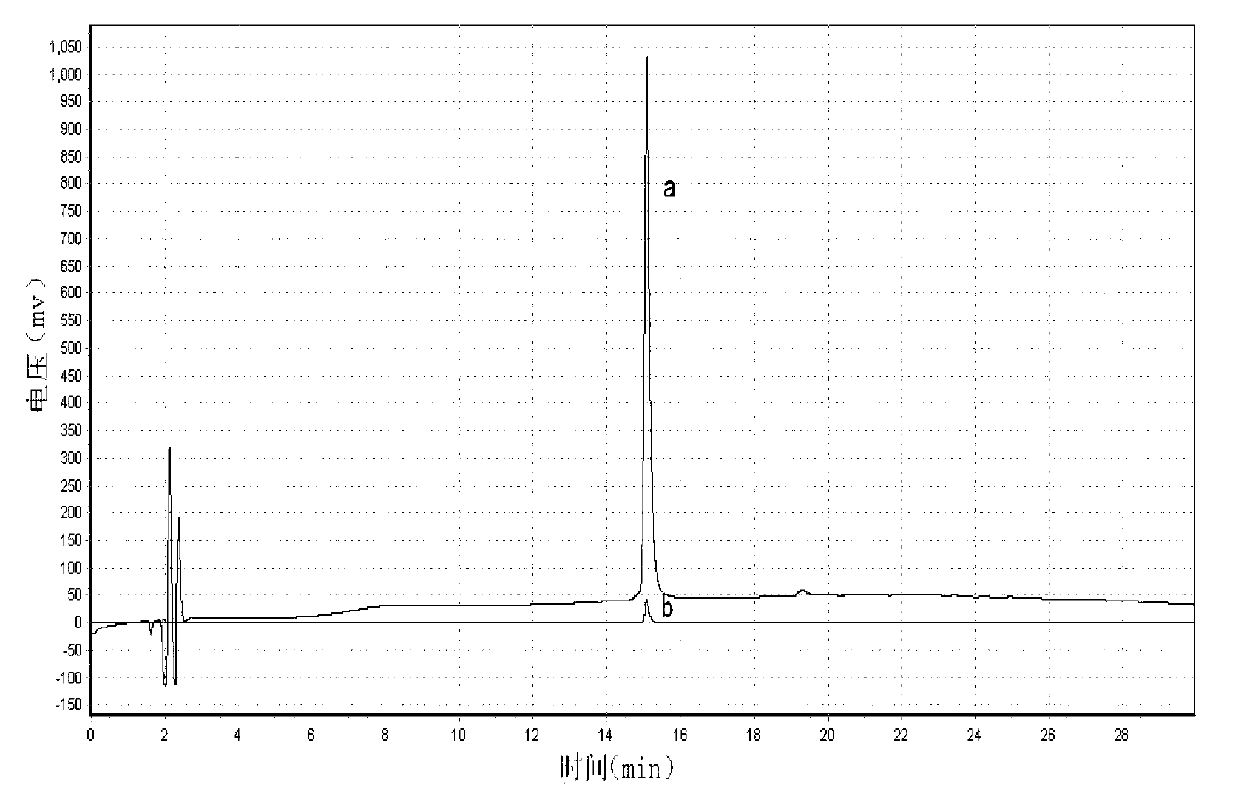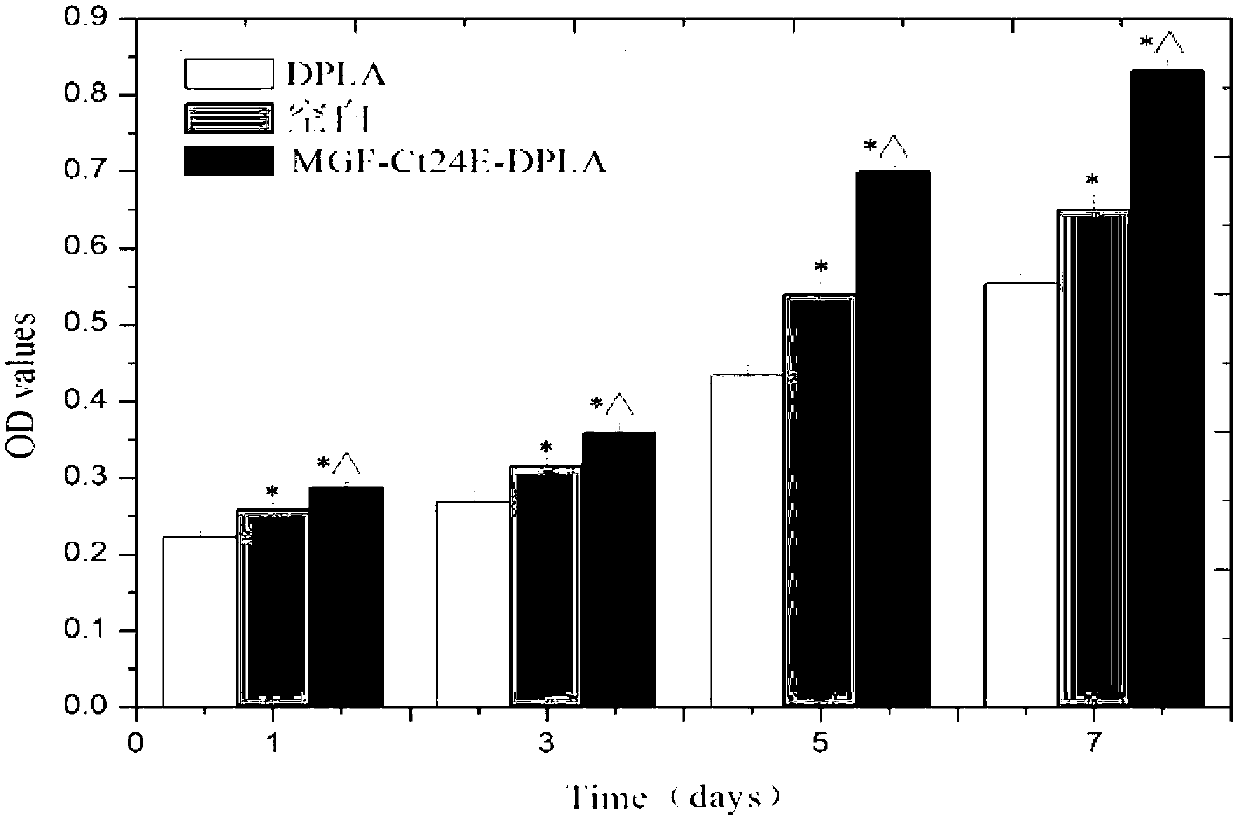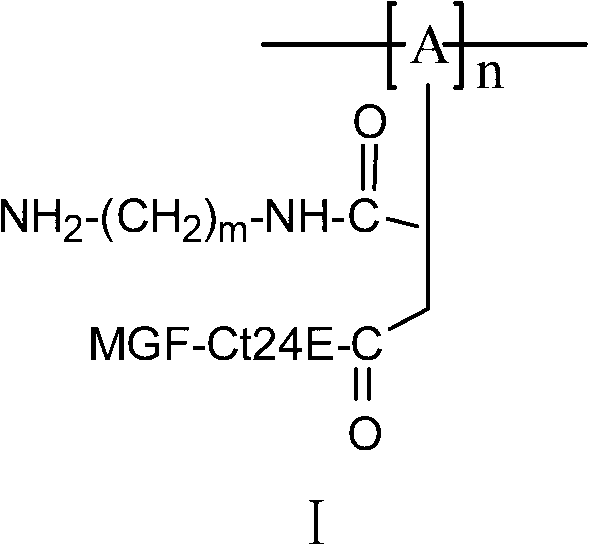Poly(DL-lactic acid) material modified based on 24 peptides in E domain of mechano-growth factor (MGF) and diamine, and preparation method and application thereof
A growth factor and domain technology, applied in the direction of prosthesis, medical science, etc., can solve the problems such as no other reports, achieve good hydrophilicity, cell affinity and biodegradability, and improve the effect of stress deficiency
- Summary
- Abstract
- Description
- Claims
- Application Information
AI Technical Summary
Problems solved by technology
Method used
Image
Examples
Embodiment 1
[0036] The preparation of embodiment 1 maleic anhydride modified polylactic acid
[0037] Mix 5.0 g of poly-D, L-lactic acid, 0.5 g of maleic anhydride, and 10 mg of tert-butyl peroxide evenly, and vacuum melt and seal it in a 50 ml round bottom flask. React at 50°C for 24 hours to obtain brown-yellow maleic anhydride-modified polylactic acid. The product was dissolved in dichloromethane and dropped into excess ether, and the precipitate was collected. Repeat to dissolve the pellet three times. The precipitate was placed under vacuum at room temperature for 48 hours to obtain 3.8 grams of brown maleic anhydride-modified polylactic acid, the molecular formula of which is as follows: Wherein A is D, L-lactic acid. In addition, through parallel tests: when A is D-lactic acid or L-lactic acid, it can all be realized.
Embodiment 2
[0038] The preparation of embodiment 2 maleic anhydride modified polylactic acid
[0039] 5.0 g of poly(D,L-lactic acid), 0.5 g of maleic anhydride, and 20 mg of tert-butyl peroxide were mixed evenly, and vacuum melted and sealed in a 50 ml round bottom flask. React at 50°C for 24 hours to obtain brown-yellow maleic anhydride-modified polylactic acid. The product was dissolved in dichloromethane and dropped into excess ether, and the precipitate was collected. Repeat to dissolve the pellet three times. The precipitate was placed under vacuum for 48 hours at room temperature to obtain 3.5 grams of brown maleic anhydride-modified polylactic acid, the molecular formula of which is Wherein A is D, L-lactic acid. In addition, through parallel tests: when A is D-lactic acid or L-lactic acid, it can all be realized.
Embodiment 3
[0040] The preparation of embodiment 3 maleic anhydride modified polylactic acid
[0041] 5.0 g of poly(D,L-lactic acid), 0.5 g of maleic anhydride, and 30 mg of tert-butyl peroxide were uniformly mixed, vacuum melted and sealed in a 50 ml round bottom flask. React at 50°C for 24 hours to obtain brown-yellow maleic anhydride-modified polylactic acid. The product was dissolved in dichloromethane and dropped into excess ether, and the precipitate was collected. Repeat to dissolve the pellet three times. The precipitate was placed under vacuum at room temperature for 48 hours to obtain 4.2 g of brown maleic anhydride-modified polylactic acid, the molecular formula of which is as follows: Wherein A is D, L-lactic acid. In addition, through parallel tests: when A is D-lactic acid or L-lactic acid, it can all be realized.
PUM
| Property | Measurement | Unit |
|---|---|---|
| water absorption | aaaaa | aaaaa |
Abstract
Description
Claims
Application Information
 Login to View More
Login to View More - R&D
- Intellectual Property
- Life Sciences
- Materials
- Tech Scout
- Unparalleled Data Quality
- Higher Quality Content
- 60% Fewer Hallucinations
Browse by: Latest US Patents, China's latest patents, Technical Efficacy Thesaurus, Application Domain, Technology Topic, Popular Technical Reports.
© 2025 PatSnap. All rights reserved.Legal|Privacy policy|Modern Slavery Act Transparency Statement|Sitemap|About US| Contact US: help@patsnap.com



